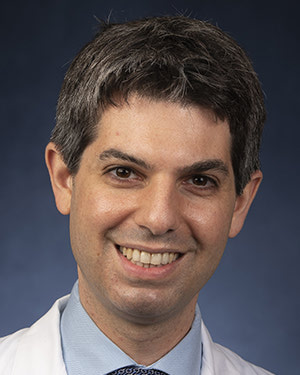Burst of Treatment Options in HCC Complicates Sequencing Decisions
Options for systemic treatment for patients with hepatocellular carcinoma have significantly expanded since 2017, when the sole available option was sorafenib. Now, the arsenal includes checkpoint inhibitors, targeted therapies, and combinations of both classes of drugs.
Mark Yarchoan, MD

Options for systemic treatment for patients with hepatocellular carcinoma (HCC) have significantly expanded since 2017, when the sole available option was sorafenib (Nexavar). Now, the arsenal includes checkpoint inhibitors, targeted therapies, and combinations of both classes of drugs, explained Mark Yarchoan, MD, in a virtual presentation during the 2021 HCC-TAG Congress.1
These therapeutic additions have led to improved survival for patients, while making it more difficult for physicians to determine the best way to sequence treatments.
Yarchoan, an assistant professor of medicine and coleader of the Liver Cancer Multidisciplinary Clinic at Johns Hopkins Medicine, detailed the sequencing possibilities for patients with HCC in his presentation. Part of the challenge in making treatment decisions, he said, is that most of the agents approved in the second-line setting were tested against sorafenib, known as the previous standard of care.
However, in May 2020, the FDA approved atezolizumab (Tecentriq) plus bevacizumab (Avastin), based on results from the phase 3 IMbrave150 (NCT03434379) trial. Data showed that the combination improved overall survival (OS) vs sorafenib in patients with unresectable or metastatic HCC who had not received prior systemic therapy.2
“Bevacizumab/atezolizumab is the first therapy to demonstrate improved OS over sorafenib in the frontline setting. Consequently, I imagine many patients will be treated with [this combination],” he said. “However, this really sets up a challenge for us because no therapy has ever been studied in second line after prior bevacizumab/atezolizumab, at not least prospectively.”
At present, regorafenib (Stivarga), cabozantinib (Cabometyx), and ramucirumab (Cyramza) have demonstrated a survival benefit in the second-line setting compared with placebo in patients with HCC. Yarchoan cautioned that cross-trial comparisons cannot be done, as the trials exploring each of the 3 agents were comprised of patient populations not identifical to one another.
In the phase 3 RESOURCE trial (NCT01774344), the median OS was 10.6 months with regorafenib plus best supportive care in patients with HCC who previously received sorafenib compared with 7.8 months for placebo plus best supportive care, representing a 38% reduction in the risk of death (HR, 0.62; 95% CI, 0.50-0.78; P <.001).3 In April 2017, the FDA approved regorafenib in this setting based on the RESOURCE data.
The approval for cabozantinib in patients with HCC who had previously received sorafenib and had Child Pugh Class A liver impairment was based on findings from the CELESTIAL (NCT01908426) trial.4 Here, the median OS was 10.2 months for patients receiving cabozantinib and 8.0 months for those receiving placebo (HR, 0.76; 95% CI, 0.63-0.92; P = .0049).
Additionally, ramucirumab monotherapy is approved for patients with an alpha fetoprotein (AFP) of at least 400 ng/mL and have been previously treated with sorafenib, based on findings from the international, double-blind, placebo-controlled, multicenter, phase 3 REACH-2 trial. The median OS was 8.5 months with ramucirumab compared with 7.3 months with placebo (HR, 0.71; 95% CI, 0.53-0.95; P = .020) in patients who progressed or who were intolerant to frontline sorafenib.5
“For patients who received first-line sorafenib, any of our approved second-line agents are very reasonable,” Yarchoan said. “This includes second-line therapies, as well as nivolumab/ipilimumab, which is approved based on single-arm, phase 2 data. But the activity is very intriguing, and I think it is a quite reasonable option in the second-line [setting].”
The combination of nivolumab (Opdivo) and ipilimumab (Yervoy) is also approved in this setting after demonstrating activity in the phase 2 CheckMate-040 (NCT01658878) trial. The combination of anti–PD-1 and anti–CTLA-4 agents induced an overall response rate of 32% with 4 complete responses.6
“In the largest studies of PD-1 monotherapy, we have seen response rates in a range of 14% to 17%. In this case, the response rate was almost…32%, so the anti–CTLA-4 is clearly adding something,” Yarchoan said. “This added activity comes at a cost of immune-related adverse events [irAEs]. When we look at the [irAE] rates, more than 50% of patients had either grade 3 or grade 4 toxicity with the approved dosing of nivolumab/ipilimumab. This clearly has activity, but where it belongs in the evolving landscape of HCC remains unclear.”
Yarchoan said treatment is more complicated for patients who receive atezolizumab/bevacizumab in the first-line setting. Generally speaking, he prefers to use a tyrosine kinase inhibitor (TKI) following that combination, but it is not yet clear which available TKI is most appropriate.
“Some people would argue that we should just push the entire treatment landscape back—sorafenib and lenvatinib [Lenvima] are very reasonable options in the second-line setting after prior bevacizumab/atezolizumab,” he added. “Conversely, there’s a strong rationale for using a traditional second line TKI after prior bevacizumab/atezolizumab. In my in my experience, cabozantinib can be used effectively in this setting and I feel quite comfortable using cabozantinib because it’s shown activity after prior anti-VEGF [therapy].”
References
- Yarchoan M. Sequencing systemic therapy: second-line and beyond. Presented at: 2021 HCC-TAG Conference; March 26-27, 2021; virtual.
- FDA approves atezolizumab plus bevacizumab for unresectable hepatocellular carcinoma. FDA. June 1, 2020. Accessed March 26, 2021. https://bit.ly/39AgpGf
- FDA expands approved use of Stivarga to treat liver cancer. FDA. April 27, 2017. Accessed March 26, 2021. https://bit.ly/3rs2sQs
- FDA approves cabozantinib for hepatocellular carcinoma. FDA. March 12, 2019. Accessed March 26, 2021. https://bit.ly/31nF3Fq
- FDA approves ramucirumab for hepatocellular carcinoma. FDA. May 10, 2019. Accessed March 26, 2021. https://bit.ly/3wdfaX8
- FDA grants accelerated approval to nivolumab and ipilimumab combination for hepatocellular carcinoma. FDA. March 11, 2020. Accessed March 26, 2021. https://bit.ly/3cqNZQM



